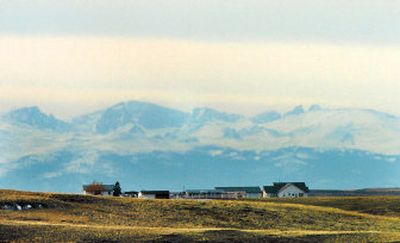Visiting ‘Brokeback’ mountains

There is no Brokeback Mountain. But that doesn’t mean people won’t pay to see it.
The mountain, like the Annie Proulx short story that spawned the Oscar-nominated movie, is fictional.
Proulx placed it somewhere in Wyoming’s Bighorn Mountains. The movie’s director, Ang Lee – because it was cheaper – shot the film in Alberta, along the Canadian Rockies, primarily in the Kananaskis Country area near Banff National Park.
If you film it, people come.
Erica Backus of the Savannah Convention and Visitors Bureau witnessed firsthand the phenomenal interest created in the Georgia city a decade ago by the book, then the movie, “Midnight in the Garden of Good and Evil.”
“It’s amazing,” she says, “what cinema can bring out in a person, how the need to go see and touch and hear scenes from their favorite movies can really influence their vacation decisions.”
But where “Shane” brought Wyoming’s Grand Tetons into national focus and “Close Encounters of the Third Kind” generated detours to see Devils Tower, “Brokeback Mountain” – a tale of cowboy-cowboy love – carries with it a unique kind of baggage.
Ten Sleep is a little town (pop. 300) at the base of the Bighorns that has drawn some attention as the nearest settlement to the country that likely inspired Proulx, who visited the area.
“It’s a charming little place,” says Diane Shober, director of Wyoming’s state travel office. “It is absolutely breathtaking.”
The nearest sizable town is Worland (pop. 5,200), 25 miles west.
“Hopefully, it will have a positive effect,” says Mike Willard, executive director of the Worland-Ten Sleep Chamber of Commerce. “We’ve got beautiful country out here, and a lot of great people, and we’re very open to everybody and anybody – and come on out and visit.”
Some of those great people, evidently, are more open than others.
“In this area, we don’t deal well with … whatever you want to call ‘em,” says Darell Ten Broek, who operates Ten Broek RV Park, Cabins and Horse Hotel in Ten Sleep.
“Not that it doesn’t go on. There’s a couple that have been in this town since I’ve been here and everybody leaves them alone, but it just isn’t very well accepted here.”
Ten Broek, 62, has been a rancher, cowboy, competed in rodeos. “I’ve lived within 300 miles of here all my life,” he says.
He hasn’t seen the movie, and he won’t.
“And I think most people that I talk to around here feel the same way about it,” he says. “They don’t feel it’s depicting Wyoming or real cowboys or real ranchers at all. It’s just kind of a slap in the face.”
Even the chamber’s Willard concedes not everyone is thrilled.
“My mother’s family has been around the area since about 1893,” he says, “and she’s enjoyed the other books she’s read by this gal, but this one did not impress her at all. She felt it portrayed us as a bunch of demented hicks.”
Nonetheless, people of all persuasions, lured by the promise of pristine wilderness and the unquestionably romantic setting, are sure to come on out and visit.
Some may wind up visiting the Wyoming mountains shown in the movie’s ads and posters, and they’ll be dazzled – and wrong.
“Yep, that’s the Tetons,” says Jackie Skaggs, public information officer for Grand Teton National Park, about 275 road miles (150 as the eagle flies) west of the Bighorns.
At least they’re in the designated state, where Shober says half the calls coming into her office are about Brokeback.
” ‘Is Brokeback Mountain a real mountain? Is there a place where we can go?’ They’re seeing the wide-open spaces that are indicative of Wyoming,” she says, “so we’re excited for what that could mean for us.”
So is Alberta.
There may be no more beautiful stretch of mountain scenery in the world than the Rockies from Waterton-Glacier International Peace Park, which straddles the Montana-Alberta border, through Banff and Jasper National Parks.
Unlike most of Wyoming’s Bighorn region, the Rockies along the Alberta-British Columbia line have been a serious tourist draw for generations, spawning world-class hotels, spas and ski resorts. Diversity, of all kinds, is nothing new.
“There’s always been a gay-friendly community here,” says Judy Love Rondau, representing Travel Alberta. But she insists the increased interest in her region has little to do with the “Brokeback” story line.
“The beauty of the scenery actually overwhelms the story,” she says. “Everybody I know who’s seen the movie, whether they like the story line or not, says, ‘My gosh, it looks like it goes on forever.’
“I don’t think people realize there’s countryside like this left.”
Much of Savannah was scandalized by “Midnight in the Garden of Good and Evil,” says the Convention and Visitors Bureau’s Backus. That story involved murder, high society, homosexuality and prominently featured a black drag queen.
“When the book first came out,” Backus says, “people did have that feeling about it, like, ‘Oh, my God, they’ve aired all our dirty laundry.’
“But then people started to say, ‘Hey, there’s 10 million people in town eating at our restaurants, shopping in our shops, patronizing our businesses.’ “
Backus’ message to Alberta and, yes, to Wyoming:
“Embrace what you can. Everyone benefits. All tourists are good tourists.”